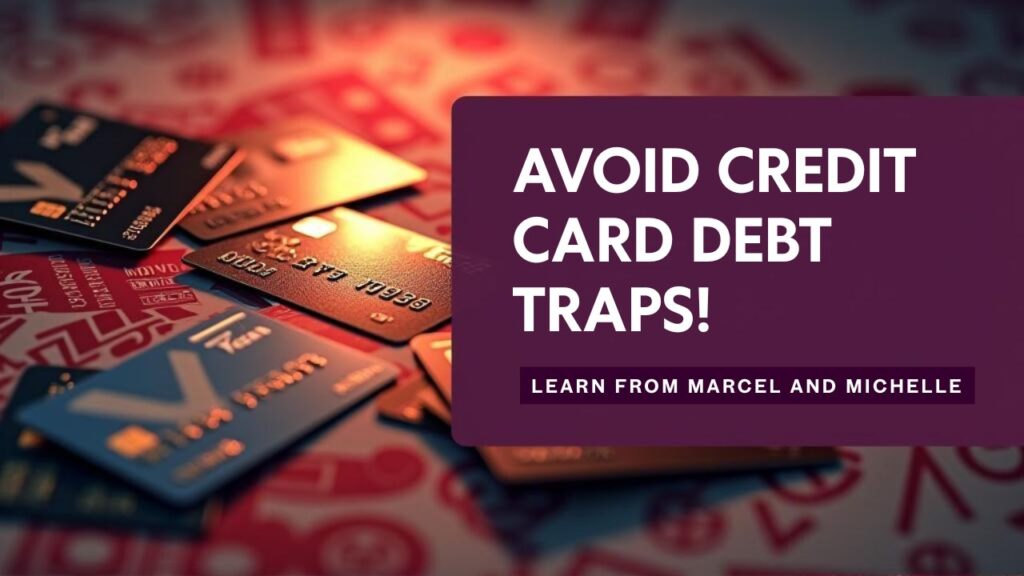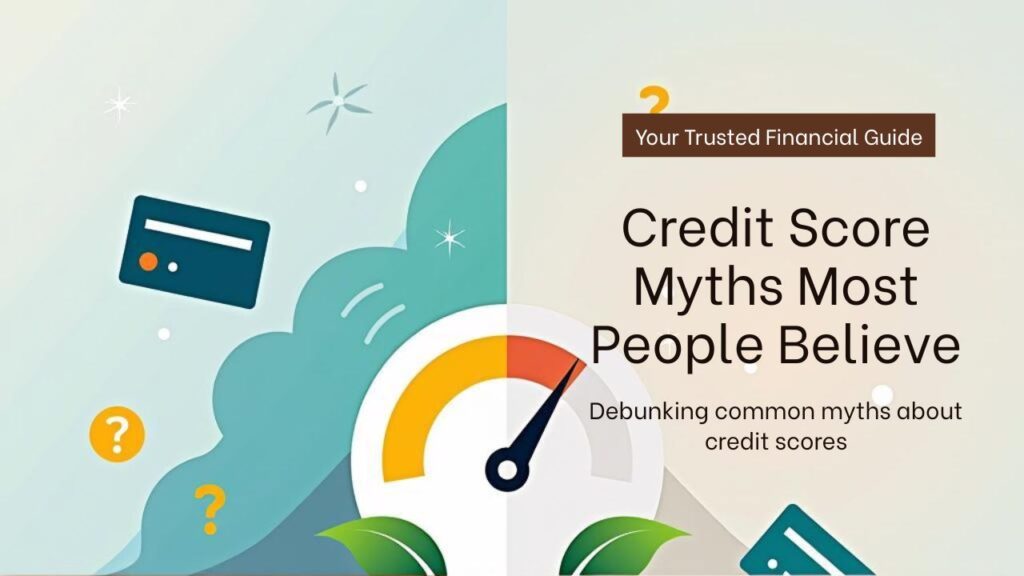How Marcel & Michelle Slipped Into Credit-Card Debt—and How You Can Dodge the Same Trap

Two young professionals thought plastic would smooth life’s bumps; instead, revolving balances ate their paychecks. Their story—told step by step, number by number—reveals why millions fall behind and what it really takes to climb out.
Snapshot of the Journey
Marcel (29, marketing) and Michelle (27, graphic design) seemed financially comfortable: joint take-home pay topped ₹1,40,000 a month. But inside three years they built a ₹5,60,000 credit-card balance, paying close to 24% APR. Overspending, inflation-driven day-to-day charges, and the seductive “minimum-payment option” pushed them into a cycle familiar to roughly 46% of card-using households who roll balances from month to month.
Table 1. Eight Core Mistakes—and How Common They Are
| # | Debt Driver | Their Behavior | Industry Data |
|---|---|---|---|
| 1 | Lifestyle inflation | Upgraded phones, fine-dining every weekend | Overspending is a top driver of card debt |
| 2 | Daily essentials on credit | Groceries, utilities, fuel on cards | 54% of maxed-out cardholders blame rising prices |
| 3 | No emergency fund | ₹0 savings when car repair cost ₹60,000 | 38% cite emergencies for maxing cards |
| 4 | Minimum-payment habit | Paid only 2-3% of balance monthly | Minimum payments extend debt for decades |
| 5 | Multiple high-APR cards | Five cards, none below 22% APR | Average APR hovers near 24.7% |
| 6 | Poor budget tracking | Ignored spending-tracker apps | Lack of budget fuels debt growth |
| 7 | Credit-score blind spot | Unaware 80% utilization tanked score | High utilization can drop scores 80 points |
| 8 | FOMO & social pressure | Travel splurges for Instagram posts | Social spending often triggers card use |
1. The Spark: Reward Points, Sign-Up Bonuses & Early Overspending
Marcel opened his first rewards card for airline miles; Michelle grabbed a cash-back card “just for groceries.” Within months they were chasing sign-up bonuses, opening three more accounts, and rationalizing bigger purchases because “points would offset the cost.” Overspending is the #1 route into card debt for U.S. consumers, especially when store-cards and travel perks dangle in front of them.
2. Plastic for Necessities: When Inflation Bites
By year two, soaring rent, fuel, and grocery bills outpaced their salaries. They started charging everyday items “just till payday.” They aren’t alone: 2-in-5 cardholders have maxed out or nearly maxed a card since 2022, and more than half cite inflation as the reason. Using credit for staples is risky because balances don’t shrink—food is eaten long before the bill is paid.
3. The Minimum-Payment Mirage
Their statements showed a ₹12,000 “minimum due.” Paying that felt doable—until they realized only ₹1,500 hit the principal while ₹10,500 covered interest and fees. This “minimum-payment trap” is deliberately engineered to keep balances revolving. At a 24% APR, a ₹3,00,000 balance paid at 2% per month would take 17+ years and more than ₹4,00,000 in interest before disappearing.
Quick Math
Monthly interest rate ≈ 2%
Minimum payment = ₹6,000 (2% of ₹3,00,000)
Principal paid first month ≈ ₹6,000 − ₹6,000 × 0.83 ≈ ₹1,020
Progress feels slow because it is slow.
4. When 80% Utilization Trips Alarms
By month 26, Marcel’s primary card reported 83% utilization. Credit bureaus treat anything above 30% as high risk; scores can slide 50-80 points in a single cycle. A lower score bumped their car-loan rate by 2.1 percentage points, adding ₹1,700 to each EMI.
5. Psychological Potholes on the Road to Debt
-
Instant gratification: Swiping plastic releases a dopamine hit; pain of payment is delayed.
-
Anchoring bias: 0%-EMI ads focus attention on monthly outgo, not total cost.
-
Social proof: Trending gadgets and travel vlogs convince users “everyone is doing it.”
-
Loss aversion: Paying cash hurts, so people subconsciously avoid it.
These biases drive the “spend now, worry later” mindset.
6. Crunching Their Spiral in Plain Numbers
They carried five cards averaging ₹1,12,000 each:
| Card | Balance (₹) | APR | Min. Payment (2%) | Interest Month 1 | Net Principal Paid |
|---|---|---|---|---|---|
| Travel Rewards | 1,25,000 | 24% | 2,500 | 2,500 | 0 |
| Grocery Cash-Back | 95,000 | 23% | 1,900 | 1,821 | 79 |
| Electronics Store | 1,10,000 | 26% | 2,200 | 2,383 | (−183) |
| General Cash-Back | 75,000 | 22% | 1,500 | 1,375 | 125 |
| Fuel Co-brand | 1,55,000 | 25% | 3,100 | 3,229 | (−129) |
| Total | 5,60,000 | — | 11,200 | 11,308 | (−108) |
Even after paying ₹11,200, their debt grew by ₹108.
7. The Wake-Up Call
-
Card declined: Michelle’s card bounced at a supermarket checkout.
-
Collection calls: Two issuers rang five times a day once payments arrived late.
-
Score shock: Experian alert showed a 92-point drop—enough to disqualify their planned home loan.
8. Blueprint for Reversal
8.1 Budget Autopsy & Cash-Flow Rewire
They listed every rupee, then cut ₹18,000 in subscriptions and impulse buys. A zero-based budget allocated every remaining rupee a “job.”
8.2 Seed an Emergency Fund
First ₹1,00,000 went into a high-yield savings account—so car repairs no longer ride on plastic.
8.3 Choose the Payoff Method
-
Snowball: Michelle cleared a ₹25,000 store card first for morale.
-
Avalanche: Marcel tackled the 26% APR card next; saved ₹21,000 interest in 12 months.
8.4 0% Balance Transfer
They shifted ₹1,20,000 to a 0% BT card (3% fee). Even with the fee, they saved ₹18,000 interest that year.
8.5 APR Negotiation
After 12 on-time payments, they requested—and received—a 6 percentage-point rate cut on two cards.
8.6 Side-Income Stack
Weekend freelance design and marketing gigs brought in an extra ₹28,000 monthly, routed entirely to debt.
Figure 1. Projected vs. Actual Payoff Timeline
| Strategy | Payoff Time | Total Interest |
|---|---|---|
| Minimum payments only | 20 years | ₹7,50,000 |
| Snowball + Avalanche + BT | 38 months | ₹1,35,000 |
By blending strategies, they shaved 16 years off the timeline.
9. FAQs Readers Ask (and Honest Answers)
Q. Is it ever okay to pay only the minimum?
Only to avoid a late fee during a one-off cash-crunch. Long-term, it locks you into a high-interest spiral.
Q. How low should utilization stay?
Scoring models favor <30%, and optimal scores often sit below 10%.
Q. Snowball vs. Avalanche—which wins?
Avalanche saves more on interest; Snowball offers psychological wins. A hybrid (small balance first, then highest APR) served Marcel & Michelle best.
Q. Will closing old cards boost my score?
No; it can lower the score by shrinking available credit and shortening history. Pay them off, keep them open, use sparingly.
10. Take-Home Lessons for Every Cardholder
-
Budget > Bonus Points: Chase a budget, not rewards.
-
Emergency Fund First: Credit is not a rainy-day fund.
-
Pay More Than Minimum: Even 10% above minimum slashes interest.
-
Track Utilization Weekly: Set phone alerts at 30% and 50%.
-
Negotiate Rates: Issuers often cut APR after a solid payment streak.
-
Side Hustle = Debt Killer: Extra income accelerates payoff without harming basics.
11. Action Checklist—Start Tonight
-
Download a free budgeting app and categorize last month’s spending.
-
Set autopay to statement balance or a fixed aggressive figure, never the minimum.
-
Call each issuer; ask for a rate reduction or hardship plan.
-
Research one 0% balance-transfer offer that fits your credit profile.
-
Draft a debt snowball list—smallest to largest—pin it on the fridge.
12. The Human Element: How They Feel Now
Eighteen months into their turnaround, Marcel calls every zero-balance letter “a mini graduation.” Michelle sleeps better “knowing tomorrow’s emergencies won’t swipe today’s paycheck.” More than the numbers, regaining control proved priceless.
Final Word
Credit cards are tools—scalpels, not swords. Handled carefully, they build credit and earn perks; waved around, they cut deep. Marcel & Michelle’s ordeal shows that escaping the debt labyrinth starts with facing the math, curbing the mind games, and committing to a structured, aggressive plan. Master those, and plastic stops feeling like a trap—and starts acting like the simple convenience it was always supposed to be.


